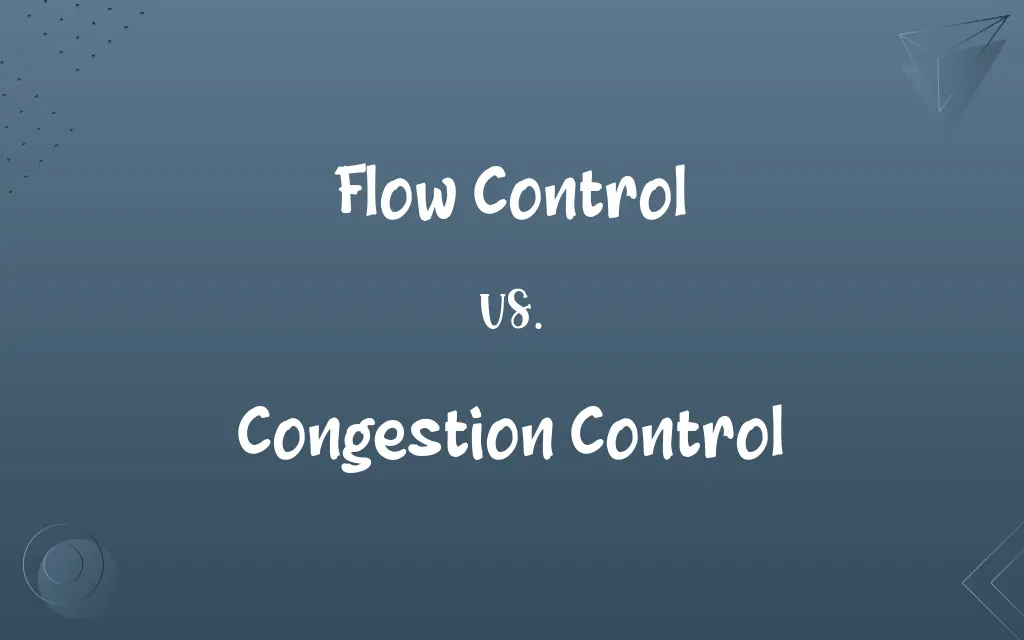Flow Control vs. Congestion Control: Know the Difference

By Shumaila Saeed || Updated on December 25, 2023
Flow Control manages data transfer between devices to prevent overflow, while Congestion Control regulates network traffic to avoid overload.

Key Differences
Flow Control is a mechanism in data communication that ensures a sender does not overwhelm a receiver by sending too many packets at once. It is concerned with maintaining a pace that both sender and receiver can handle. Conversely, Congestion Control deals with managing the overall traffic on the network to prevent or mitigate network congestion, which can occur when too many packets are present in the network, leading to packet loss and delays.
Shumaila Saeed
Dec 22, 2023
In Flow Control, techniques like stop-and-wait or sliding window are used to control the rate of data transmission. This process is essential in ensuring that the receiver's buffer does not overflow. On the other hand, Congestion Control utilizes methods like congestion avoidance and congestion detection, focusing on controlling traffic entry into a network to maintain optimal network performance and prevent congestion collapse.
Shumaila Saeed
Dec 22, 2023
Flow Control operates at a point-to-point level, primarily between two directly connected devices. It ensures that the transmitting device does not send data faster than the receiving device can process. In contrast, Congestion Control functions at a network level, addressing how all devices on a network manage shared network resources and data transmission rates to prevent widespread congestion.
Shumaila Saeed
Dec 22, 2023
In terms of application, Flow Control is critical in maintaining the integrity of data transmission between two points, preventing data loss and ensuring efficiency. Congestion Control, however, is vital for maintaining overall network health, ensuring that all users on a network can communicate effectively without overwhelming the network's capacity.
Shumaila Saeed
Dec 22, 2023
Both Flow Control and Congestion Control are essential in computer networks, but they address different aspects: Flow Control manages the data transfer pace between individual devices, while Congestion Control manages the overall data traffic within the network to prevent congestion.
Shumaila Saeed
Dec 22, 2023
ADVERTISEMENT
Comparison Chart
Focus
Managing data transfer between two devices
Regulating overall network traffic
Shumaila Saeed
Dec 22, 2023
Level of Operation
Point-to-point level between sender and receiver
Network level, involving all network devices
Shumaila Saeed
Dec 22, 2023
Techniques Used
Stop-and-wait, Sliding window
Congestion avoidance, Congestion detection
Shumaila Saeed
Dec 22, 2023
Main Objective
Prevent receiver's buffer overflow
Avoid network congestion and maintain network health
Shumaila Saeed
Dec 22, 2023
Operational Environment
Directly connected devices
Across entire network with multiple connected devices
Shumaila Saeed
Dec 22, 2023
ADVERTISEMENT
Flow Control and Congestion Control Definitions
Flow Control
A process to synchronize sender and receiver data speeds.
In our network, flow control is critical to keep data transfers smooth and consistent.
Shumaila Saeed
Dec 05, 2023
Congestion Control
Regulates entry of traffic into a network.
Our network uses congestion control algorithms to manage the flow of incoming and outgoing data.
Shumaila Saeed
Dec 05, 2023
Flow Control
Controls data transfer to match receiver's processing ability.
Effective flow control prevents data bottlenecks in busy networks.
Shumaila Saeed
Dec 05, 2023
Congestion Control
Prevents network congestion collapse.
Implementing congestion control helps us avoid total network failures during heavy data exchange periods.
Shumaila Saeed
Dec 05, 2023
Flow Control
Regulates the rate of data transmission between two points.
Flow control ensures that our server doesn't get overwhelmed by client requests.
Shumaila Saeed
Dec 05, 2023
ADVERTISEMENT
Congestion Control
Manages overall data traffic in a network to prevent overload.
Congestion control techniques are essential in our high-traffic network to avoid delays.
Shumaila Saeed
Dec 05, 2023
Flow Control
Maintains a balance in data transfer rate to prevent loss.
Flow control mechanisms adjust data flow to match the receiver's capacity.
Shumaila Saeed
Dec 05, 2023
Congestion Control
Aims to maintain optimal network performance.
Through congestion control, we can keep the network running smoothly even during peak usage.
Shumaila Saeed
Dec 05, 2023
Flow Control
Mechanism to prevent data overflow between sender and receiver.
The sliding window method in flow control helps manage data transmission efficiently.
Shumaila Saeed
Dec 05, 2023
Congestion Control
Involves techniques like congestion avoidance and detection.
With congestion control, the network can detect potential overload issues and adjust accordingly.
Shumaila Saeed
Dec 05, 2023
Repeatedly Asked Queries
What is Congestion Control?
It's a method to regulate overall network traffic to prevent network congestion.
Shumaila Saeed
Dec 22, 2023
What's the purpose of Congestion Control?
To manage the volume of traffic in a network, ensuring optimal performance and preventing congestion.
Shumaila Saeed
Dec 22, 2023
What is Flow Control?
It's a mechanism to manage data transfer between devices, preventing overflow.
Shumaila Saeed
Dec 22, 2023
Is Flow Control the same as Congestion Control?
No, Flow Control is about managing data transfer between two devices, while Congestion Control is about managing overall network traffic.
Shumaila Saeed
Dec 22, 2023
What happens if Flow Control fails?
It can lead to data overflow, causing loss of data or buffer overflow at the receiver end.
Shumaila Saeed
Dec 22, 2023
How does Congestion Control maintain network health?
By regulating data entry and traffic flow, it keeps the network from becoming overloaded.
Shumaila Saeed
Dec 22, 2023
How does Flow Control work?
It uses techniques like sliding window to synchronize data transfer rates between sender and receiver.
Shumaila Saeed
Dec 22, 2023
What role does Congestion Control play in the internet?
It's crucial for preventing congestion collapse in high-traffic situations on the internet.
Shumaila Saeed
Dec 22, 2023
What's the impact of Flow Control on data integrity?
It helps maintain data integrity by ensuring data isn't sent faster than it can be accurately processed.
Shumaila Saeed
Dec 22, 2023
Is Congestion Control important for all networks?
Yes, especially in networks with high data traffic to maintain efficiency and prevent congestion.
Shumaila Saeed
Dec 22, 2023
Does Flow Control depend on the type of connection?
Yes, its implementation can vary depending on whether the connection is wired or wireless.
Shumaila Saeed
Dec 22, 2023
Can Congestion Control algorithms be adjusted?
Yes, they can be fine-tuned based on network conditions and requirements.
Shumaila Saeed
Dec 22, 2023
Can Congestion Control prevent data loss?
Yes, by managing network traffic, it helps prevent situations that could lead to data loss.
Shumaila Saeed
Dec 22, 2023
What are common Flow Control techniques?
Techniques include stop-and-wait and sliding window protocols.
Shumaila Saeed
Dec 22, 2023
What happens during network congestion?
Network performance degrades, leading to delays, packet loss, and potentially a total collapse.
Shumaila Saeed
Dec 22, 2023
Is Flow Control necessary in all types of networks?
It's essential in networks where the receiving device's capacity may be less than the sender's data rate.
Shumaila Saeed
Dec 22, 2023
Does Congestion Control affect network speed?
It can temporarily reduce data transmission rates to prevent congestion, impacting speed.
Shumaila Saeed
Dec 22, 2023
Can Flow Control be applied in wireless networks?
Yes, it's applicable in both wired and wireless networks.
Shumaila Saeed
Dec 22, 2023
Are there different types of Congestion Control?
Yes, including proactive methods like congestion avoidance and reactive methods like congestion detection.
Shumaila Saeed
Dec 22, 2023
How is Flow Control implemented in TCP?
TCP uses a sliding window mechanism for flow control to match the sender's and receiver's capacities.
Shumaila Saeed
Dec 22, 2023
Share this page
Link for your blog / website
HTML
Link to share via messenger
About Author
Written by
Shumaila SaeedShumaila Saeed, an expert content creator with 6 years of experience, specializes in distilling complex topics into easily digestible comparisons, shining a light on the nuances that both inform and educate readers with clarity and accuracy.








































































